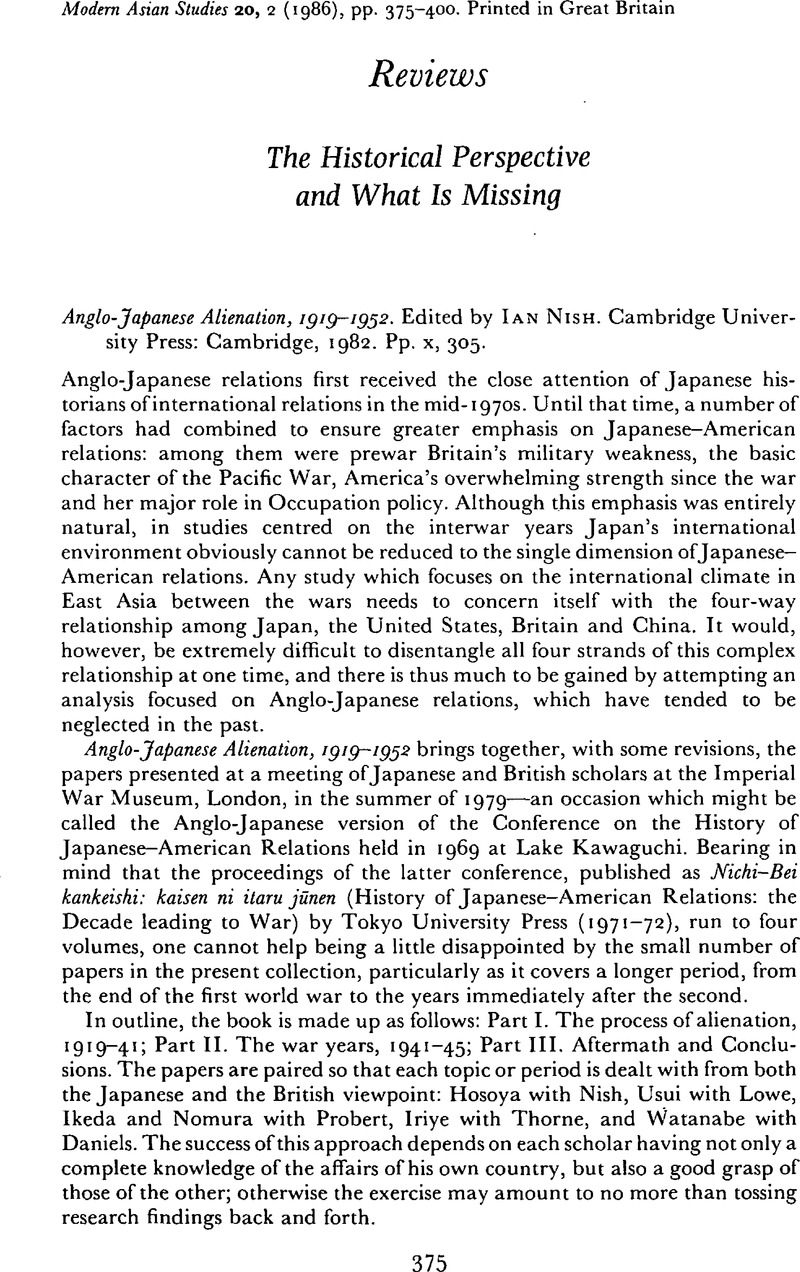Article contents
Published online by Cambridge University Press: 28 November 2008
Abstract

- Type
- Reviews
- Information
- Copyright
- Copyright © Cambridge University Press 1986
References
1 Memorandum by Viscount Cecil, 2 February 1932, Documents on British Foreign Policy, 1919–1939 (hereafter cited as DBFP), Second Series, vol. IX, pp. 312–13; Memorandum by Viscount Cecil, 6 February 1932, ibid., pp. 367–8; Lampson to Reading, 10 December 1931, DBFP, vol. VIII, p. 745; Haggie, Paul, Britannia at Bay: The Defence of the British Empire against Japan, 1931–1941 (Oxford: Oxford University Press, 1981), pp. 28–9Google Scholar; and Haggie, , ‘Admiral Sir Howard Kelly and the Shanghai Crisis of 1932,’ Naval Review, vol. LXIV, no. 3 (1976), 195–202.Google Scholar
2 Neale, R. G. et al. , Documents on Australian Foreign Policy, 1937–1949, vol. I, 1937–1938 (Canberra: Australian Government Publishing Service, 1975), p. 170.Google Scholar
3 Ibid., p. 142. This British response was probably largely influenced by the American contention that there were more than enough regional pacts in the world already and no more were needed. See Hudson, W. J., Toward a Foreign Policy (Melbourne: Cassell Australia, 1967), p. 70.Google Scholar
4 Unlike Craigie, British Ambassador to China Clark Kerr was firmly anti-Japanese. This was very natural as his mission was to close the rift in Anglo-Chinese relations as far as possible.
5 On this point, see, for example, Lee, Bradford A., Britain and the Sino-Japanese War, 1937–1939: A Study in the Dilemmas of British Decline (London: Oxford University Press, 1973), pp. 192, 212–13Google Scholar; and Sato, K., ‘Anglo-Japanese Relations, 1939–1941: Japan's Expansion and Britain's Response’ (Ph.D. Dissertation, Cambridge University Library, 1978), 68–9, 135, 172–3, 239–40.Google Scholar
6 See Churchill to Eden, 2 December 1941, FO 371/27911; Churchill, Winston S., The Second World War, vol. III, The Grand Alliance (London: Cassell, 1950), pp. 526–8; Foreign Office to Halifax (Washington), 18 October 1941, FO 371/27910; and War Cabinet Conclusions, 16 October 1941, Confidential Annex, 103(41)5, CAB 65/23.Google Scholar
7 War Cabinet Conclusions, 5 July 1940, 194(40)1, CAB 65/8.
8 Marder, Arthur J., Old Friends, New Enemies: The Royal Navy and the Imperial Japanese Navy: Strategic Illusions, 1936–1941 (Oxford: Oxford University Press, 1981), pp. 36–7; and Meeting of the Committee of Imperial Defence, 7 July 1939, CAB 2/9.Google Scholar
9 See, for example, Meetings of the Strategic Appreciation Committee, 1 and 13 March 1939 and 17 April 1939, CAB 2/8; Meeting of the Committee of Imperial Defence, 21 July 1939, CAB 2/9; and COS(39)501, 28 June 1939, CAB 80/14.
10 Japanese Foreign Ministry Archives, ‘Dai-Tōa sensō kankei ikken’, A7.0.0.9. A similar content is found in Japanese Foreign Ministry (ed.), Nichi-Bei kōshō shiryō (Records of the Japanese-American Negotiations) (Tokyo: Hara Shobō, 1978), pp. 290–1.Google Scholar It is also noteworthy that the Second Section of the Treaties Bureau of this Ministry stated in regard to the commencement of hostilities: ‘Although the conventional practice for the commencement of war has generally been first to make certain demands of the country/countries concerned and, if these are not accepted, to issue a declaration of war prior to opening hostilities, there have been recent instances due to strategic necessity in which swift and sudden action was taken without necessarily observing the above procedure … and it is therefore a frequent practice to open hostilities without a prior declaration of war’. See Japanese Foreign Ministry Archives, ‘Dai-Tōa sensō kankei ikken: kaisen kankei jūyō jikō shū’, A7.0.0. 9–51.
11 Japanese Foreign Ministry (ed.), op. cit., pp. 294–5; and Craigie to Foreign Office, 8 December 1941, FO 371/27893.
12 Craigie to Foreign Office, 2 December 1938, FO 371/23377.
13 K. Sato, ‘1941-nen nigatsu no “kiki”: Eikoku no kyokutō seisaku to Matsuoka gaishō no taiō’ (The ‘crisis’ of February 1941: Britain's Far Eastern policy and Foreign Minister Matsuoka's response), Gunji Shigaku, vol. XIV, no. 1 (1980), 16.
14 Sato, K., ‘Shingapōru kantai haken mondai to Igirisu no kyokutō senryaku’ (The question of sending a fleet to Singapore and Britain's Far Eastern strategy), Kokusai Seiji, no. 72 (1982), 122.Google Scholar
- 1
- Cited by


